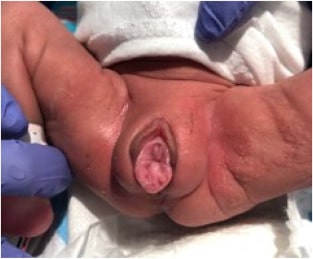Uterine Prolapse After Birth: A Warm Guide for New Parents
Hi there, amazing parents! Bringing a new life into the world is an incredible journey, filled with joy, love, and some challenges along the way. One such challenge you may have heard about or are experiencing is uterine prolapse after giving birth. It might sound scary, but don’t you worry—we’ve got you covered with a dash of understanding and a sprinkle of reassurance!
What Is Uterine Prolapse?
First up, let’s chat about what uterine prolapse really is. After childbirth, your body goes through a lot of changes as it recovers and returns to its pre-pregnancy state. The uterus, your little one’s cozy home for nine months, is no exception. Uterine prolapse occurs when the pelvic floor muscles and ligaments stretch and weaken, providing inadequate support for the uterus. As a result, the uterus can descend into the vaginal canal. It’s sort of like a trampoline losing its springiness—if the springs aren’t as tight, things can start to droop a tad.
Signs Your Body Might Be Dropping Hints
Wondering if you might be experiencing this? Your body will give you some clues! The symptoms of uterine prolapse can vary from a subtle sensation to more noticeable signs. You might feel a heaviness or fullness in your pelvis, or like something is ‘falling out’ of your vagina. Some women experience low back pain, while others might have issues with bladder control or feel that bowel movements are more of an effort. If you’re noticing these signs, reach out to your healthcare provider—they’re your go-to support team!
Why Does Uterine Prolapse Happen After Birth?
There’s an array of reasons why uterine prolapse can happen, and many of them are linked to childbirth. A vaginal delivery, especially one involving a long labor or the delivery of a large baby, can put a significant strain on your pelvic floor muscles. Similarly, if you’ve had more than one child, the repeated stretching can make a prolapse more likely. However, there are other factors to keep in mind, like genetics, age, and lifestyle influences that could play a role as well.
You’ve Noticed Symptoms—What Next?
If you’ve spotted some of the signs we’ve mentioned, it’s important to discuss them with your healthcare provider. They can perform a pelvic exam to determine if you have uterine prolapse and assess its severity. Not every prolapse requires treatment, but knowing for sure gives you power—the power of knowledge and the power to take proactive steps toward wellness!
Treatments and Tons of Hope!
Should you need treatment, the options are plenty and will depend on the degree of prolapse, your overall health, and whether you plan to have more children. Non-surgical options include pelvic floor exercises (like Kegels) to strengthen those mighty muscles, or the use of a pessary, a device inserted into the vagina to support the uterus. For more significant cases, surgery might be considered, but that’s a conversation to have with your doctor to see what’s best for you and your body.
Parenting is a marathon, not a sprint, and sometimes hurdles like uterine prolapse can pop up unexpectedly in the race. But with the right information, a supportive healthcare team, and a dash of positivity, you can tackle this challenge head on. Stay tuned as we continue to unwrap the mysteries of postpartum recovery and provide you with the support you need on this glorious parenting voyage.
Remember, every parent’s experience is unique, and it’s absolutely okay to ask for help or advice. You’re doing an incredible job, and we’re here to cheer you on every step of the way. Keep shining bright, superheroes of nurture, for the journey is as remarkable as the destination!

5 Essential Things Parents Should Know in Preparing for Uterine Prolapse After Birth
1. Knowledge is Empowerment
Understanding the basics of what uterine prolapse is, can equip you with the tools to recognize the signs early. It’s this very knowledge that can lead to a speedy consultation with your healthcare professional and appropriate management. Read up, ask questions, and stay informed about the ways you can help your body during the healing process post-partum.
2. Pelvic Floor Exercises Are Your Friend
One of the most effective things you can do to prepare and possibly prevent uterine prolapse is to strengthen your pelvic floor muscles. Exercises like Kegels can be done during early pregnancy and resumed postpartum, as advised by your healthcare provider. They are simple yet powerful and can make a world of difference in fortifying those crucial muscles.
3. Be Mindful of Your Body During Pregnancy and Birth
Listen to your body during pregnancy and childbirth. Opting for positions that lessen the strain on your pelvic floor and seeking expert guidance on how to push effectively during labor can help. If you feel something isn’t right postpartum, don’t hesitate to speak up. Timely and appropriate action can prevent more severe prolapse.
4. Lifestyle Factors Matter
Your lifestyle choices can influence your recovery after childbirth and your risk for uterine prolapse. Maintaining a healthy weight, avoiding smoking (which can affect tissue resilience), and practicing safe lifting techniques can all play a supportive role in your pelvic health.
5. Know Your Treatment Options
Should you encounter uterine prolapse, it’s beneficial to have a sense of the treatment options available. From pessaries and physiotherapy to potential surgical methods, being prepared with this knowledge can reduce stress and make decision-making smoother should the need arise.
Every step you take towards understanding and preparing for uterine prolapse is a stride towards a healthier postpartum experience. While the focus is often on the baby once they arrive, it’s equally important to take care of the superhero that made it all possible—you! So keep doing an amazing job, take good care of yourself, and know that you’re fully supported on this extraordinary journey of parenthood.
Now, you have a treasure chest of information about uterine prolapse after birth at your fingertips. Whether it’s staying vigilant for signs, adopting preventative measures, or considering treatment options, you’re well-equipped to navigate this postpartum condition with confidence and grace. Armed with knowledge and a pinch of optimism, you’re ready to face the challenge if it arises and continue to be the rockstar parent you are meant to be. So, let’s keep moving forward, growing stronger together and embracing the beautiful, complex journey of parenthood!
See more great Things to Do with Kids in New Zealand here. For more information see here
Disclaimer
The articles available via our website provide general information only and we strongly urge readers to exercise caution and conduct their own thorough research and fact-checking. The information presented should not be taken as absolute truth, and, to the maximum extent permitted by law, we will not be held liable for any inaccuracies or errors in the content. It is essential for individuals to independently verify and validate the information before making any decisions or taking any actions based on the articles.




